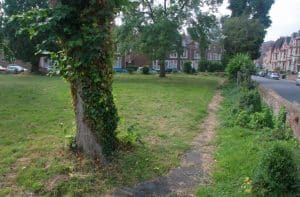Support us from £3/month
We deal with almost 1000 cases a year assisting communities, groups and individuals in protecting their local spaces and paths in all parts of England and Wales. Can you help us by joining as a member?
Our case officer Nicola Hodgson gives a snapshot of her work for the society, both in and out of the office.
As case officer for commons, greens and open spaces over the last 17 years I have experienced a huge volume and variety of issues and shared some of the frustrations, challenges and successes of members of the society.
In my daily contact with members and other organisations, the range of inquiries and difficulties is still a surprise, even after all those years. It may be a simple question about the size of a map required for a village-green application, but it might be a thick bundle of documents to be assessed when objections have been submitted to a green application, or I may need to review new court cases to ensure up-to-date information is on our website.
Evidence
People often cannot accept that they do need to provide evidence to satisfy the statutory criteria to make a village-green application; they understandably (but wrongly) believe that it should be registered simply because it is there.
Open-space concerns extend from planning applications to proposals for court action; all require research and careful analysis to determine whether it is appropriate for the society to intervene.

Queen’s Crescent Garden, designated as LGS in the Exeter St James neighbourhood plan. Photo: Aylwyn Bowen.
I have seen an increase in inquiries about local green spaces (LGS). This designation started as a proposal for statutory protection for open space to mitigate the dreadful restrictions on village-green applications in the Growth and Infrastructure Act 2013. But there is little national guidance and nothing to stop a planning application from being made before an LGS is designated.
Now members can refer to my tool kit which offers guidance on designation. That is often the way with my job—I only realise that a guidance note or case summary is needed when I have already answered lots of queries individually.
Happily, in Wales the position is different and I spent a great deal of time putting together a brief and gave evidence to the environment committee when the Welsh planning bill was being considered. The hard work paid off and the Planning (Wales) Act 2015 is not as damaging as the 2013 act in England.
In fact in Wales the village green provisions have still to be brought into force; I encourage all those in Wales who have evidence to satisfy the criteria to register land as a village green to make an application sooner rather than later. Next year may be too late.
External bodies
In addition to my case work I represent the society on several external bodies. One of these is the National Common Land Stakeholder Group hosted by Defra, which was set up to assist and advise on the implementation of the Commons Act 2006.
Our last meeting in Kendal ended with a field trip which included a visit to Ulpha Moor, common land managed under a countryside stewardship scheme. Cattle grazing has been introduced without the need for obtrusive and restrictive fencing; instead cattle-grids have been installed. The land is completely open and a wonderful example of an unenclosed common which the public can explore without physical impediment (save for the steep climbs).
However, discussions with local farmers revealed that there were clearly tensions between their plans and the restrictions imposed by Natural England. The visit also highlighted the reliance of local farmers on payment from countryside stewardship schemes. The impending changes and uncertainty as a result of Brexit were a huge concern to them.
The common-land issues I deal with daily include complaints about cows, encroachments, community involvement in consultations about the management of land, and applications for works on commons, and deregistration and exchange land under sections 38 and 16 of the Commons Act 2006 respectively.
Many of these seem straightforward, but common-land proposals are seldom simple and we need fully to understand the background before being able to comment. So time will be needed to research the registration, existing management arrangements and access rights—often even the applicants don’t understand the true position.
One recent applicant for consent for works had overlooked that it had authority to proceed under the scheme of management, and did not need consent. Another made an application for enclosure despite our correct advice that the scheme for his common prohibited it.
I run training days, usually for groups of local councils, which have proved popular in helping people through the complexities of the law and practice of common land, village greens and open spaces. We make a charge for our time and travel, but this is reduced for members of the society.
Legal strategy
I am also involved with the Wildlife and Countryside Link legal strategy group. I worked with other member organisations to submit a detailed response to the proposed changes to judicial-review rules (OS spring 2016 page 10) which are detrimental to charities. We are undertaking a detailed analysis of how Brexit will affect the environmental legislation and protections which are currently in place.
I am delighted that Hugh Craddock is now working for the society as a second case officer to assist with the ever-increasing work of protecting and creating commons, greens, rights of way and open spaces. It turns out, as we rather thought, that there is still more than enough work, and complexity, for us both to tackle.
Queen’s Crescent Garden, designated as LGS in the Exeter St James neighbourhood plan. Photo: Aylwyn Bowen.
National Common Land Stakeholder Group members on Ulpha Moor, Cumbria.

